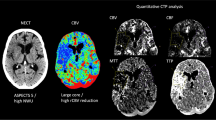Abstract
To evaluate critically perfused areas in the acute ischemic brain, 9 patients were studied by positron emission tomography (PET) within 7–32 hours after the onset. The cerebral blood flow (CBF) and oxygen metabolic rate (CMRO2) were evaluated and compared with sequential change in CT findings. In all the regions developing subsequent necrosis on CT, CBF dropped below 17 ml/100 g/min. But in some of these lesions, CMRO2 remained above the minimum value for regions in which infarction did not develop, and the tissue density on CT obviously remained normal for several hours after PET scan. The mean CBF in these lesions (14.0 ml/100 g/min, range: 9.9–17.3 ml/100 g/min) was significantly higher than that in ischemic areas with low density on CT before or just after PET study (∼10 ml/100 g/min, range: 7.7–14.1 ml/100 g/min). These findings suggest that a part of the tissue with CBF between 10–17 ml/100 g/min is still viable at least 7 hours after the onset of ischemia, but becomes non-viable in a longer period of ischemia. These lesions should respond to effective treatment, including therapeutic reperfusion.
Similar content being viewed by others
References
Del Zoppo GJ, Zeumer H, Harker LA: Thrombolytic therapy in stroke: possibilities and hazards.Stroke 17: 595–607, 1986
Mori E, Tabuchi M, Yoshida T, et al: Intracarotid urokinase with thromboembolic occlusion of the middle cerebral artery.Stroke 19: 802–812, 1988
Phillips DA, Fisher M, Smith TW, et al: The safety and angiographic efficacy of tissue plasminogen activator in a cerebral embolization model.Ann Neuroll 23: 391–394, 1988
Taneda M, Shimada N, Tsuchida T: Transient neurological deficits due to embolic occlusion and immediate reopening of the cerebral arteries.Stroke 16: 522–524, 1982
Bell BA, Symon L, Branston NM: CBF and time threshold for the formation of ischemic cerebral edema, and effect of reperfusion in baboons.J Neurosurg 62: 31–41, 1985
Slivka A, Pulsinelli W: Hemorrhagic complication of thrombolytic therapy in experimental stroke.Stroke 10: 1148–1156, 1987
Baron JC, Rougemout D, Bousser MG, et al: Local CBF, oxygen extraction fraction (OEF), and CMRO2: Prognostic value in recent supratentorial infarction in humans.J Cereb Blood Flow Metab 3 (Suppl 1): S1-S2, 1983
Jafar JJ, Crowell RM: Focal ischemic thresholds. InCerebral blood flow—physiologic and clinical aspects, Wood J (ed.), New York, McGrawHill, pp 449–457, 1987
Jones TH, Morawetz RB, Crowell RM, et al: Thresholds of focal cerebral ischemia in awake monkeys.J Neurosurg 54: 773–782, 1981
Lenzi GL, Frackowiak RSJ, Jones T: Cerebral oxygen metabolism and blood flow in human cerebral ischemic infarction.J Cereb Blood Flow Metab 2: 321–335, 1982
Morawetz RB, Crowell RM, DeGirolami U, et al: Regional cerebral blood flow threshold during cerebral ischemia.Fed Proc 38: 2493–2494, 1979
Heiss W-D: Flow threshold and morphological damage of brain tissue.Stroke 14: 329–331, 1983
Kanno I, Miura S, Yamamoto S, et al: Design and evaluation of a positron emission tomograph: HEADTOME-III.J Comput Assist Tomogr 9: 931–938, 1985
Frackowiak RSJ, Lenzi GL, Jones T, et al: Quantitative measurement of regional cerebral blood flow and oxygen metabolism in man, using15O and positron emission tomography: theory, procedure and normal values.J Comput Assist Tomogr 4: 727–736, 1980
Lammertsma A A, Jones T: Correction for the presence of intravascular oxygen-15 in the steady-state technique for measuring regional oxygen extraction ratio in the brain: 1. Description of the method.J Cereb Blood Flow Metab 3: 416–424, 1983
Miura S, Kanno I, Iida H, et al: Anatomical adjustment in brain positron emission tomography using X-ray CT images.J Comput Assist Tomogr 12: 363–367, 1988
Yamaguchi T, Kanno, I, Uemura K, et al: Reduction in regional cerebral metabolic rate of oxygen during human aging.Stroke 17: 1220–1228, 1986
Tomura N, Uemura K, Inugami A, et al: Early CT finding in cerebral infarction: Obscuration of the lentiform nucleus.Radiology 168: 463–467, 1988
Lassen NA: The luxury perfusion syndrome and its possible relation to acute metabolic acidosis localized within the brain.Lancet 2: 1113–1115, 1966
Powers WJ, Grubb LR, Darriet D, et al: Cerebral blood flow and cerebral metabolic rate of oxygen requirement for cerebral function and viability in humans.J Cereb Blood Flow Metab 5: 600–608, 1985
Sundt TM Jr, Sharbrough FS, Anderson RE, et al: Cerebral blood flow measurements and electro-encephalograms during carotid endarterectomy.J Neurosurg 41: 310–320, 1974
Trojaberg W, Boysen G: Relation between EEG, regional cerebral blood flow and internal carotid artery pressure during carotid endarterectomy.Electroencephalogr Clin Neurophysiol 34: 61–69, 1973
Powers WJ, Grubb RL, Baker RP, et al: Regional cerebral blood flow and metabolism in reversible ischemia due to vasospasm: Determination by positron emission tomography.J Neurosurg 62: 539–546, 1985
Heiss W-D, Huber M, Fink GR, et al: Progressive derangement of periinfarct viable tissue in ischemic stroke.J Cereb blood Flow Metab 12: 193–203, 1992
Author information
Authors and Affiliations
Rights and permissions
About this article
Cite this article
Higano, S., Uemura, K., Shishido, F. et al. Evaluation of critically perfused area in acute ischemic stroke for therapeutic reperfusion: A clinical PET study. Ann Nucl Med 7, 167–171 (1993). https://doi.org/10.1007/BF03164961
Received:
Accepted:
Issue Date:
DOI: https://doi.org/10.1007/BF03164961




